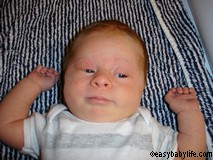This article will walk you through the 1-month-old baby development milestones to expect and give you ideas on how to play and interact with your 1-month-old. You’ll find toy tips too appropriate for this age.
Your 1-month-old baby is still a brand new little person, but now getting into the habit of living outside the womb.
Maybe your baby has started to be awake a bit more; many do “wake up” at around 1 month. However, one of my children slept almost all day long until he was 2.5 months old.
Babies are different. And his mom was quite sleepy too… ;-)
Development is, in any case, going fast. Compared to the newborn baby, a 1-month-old’s vision is already much improved, although far from perfect yet.
It is also becoming a bit easier to play with your baby. He or she will now show more interest in the surrounding world, including you. You’ll get both play tips and toy tips below.
1-Month-Old Baby Development and Activities
In this article…
1-Month-Old Baby Milestones
Things happen so fast! Here are the 1-month-old baby development milestones you will notice soon:
Physical Development
Weight and Length
Although all babies are different regarding weight and length, there are some average guidelines.
The average weight for a 1-month-old baby boy is 9 pounds 14 ounces (4.5kg), while the average weight for a 1-month-old baby girl is 9 pounds 4 ounces (4.2kg).
When it comes to length, a 1-month-old baby boy’s average length is 21.5 inches (54.7cm), and the average length for a 1-month-old baby girl is 21 inches (53.7cm).
Don’t worry if your baby’s length or weight is different from this. It is, however, important that your baby is gaining weight and growing at a healthy rate.
Eyesight
When 1 month old, your baby’s vision is improving, and looking at black and white patterns and other high-contrasting colors is very interesting for the baby.
Your baby is also attracted to light and will stare at the source of light. If an object moves slowly, a baby at this age can follow it.
A 1-month-old baby still can’t see very far and can focus on objects that are 8 – 12 inches (20-30cm) away from the face. Your sweet baby prefers looking at faces more than anything else, so hold your baby near your face so that he can see you.
It is also possible that your baby’s eyes still cross sometimes. Don’t worry; that is still considered normal at this point and should go away by the time your baby is 3 or 4 months old.
Hearing
At 1-month-old, the hearing is not very good either. Your baby can recognize some sounds from the time when she was still in the womb and might find these sounds soothing. It is also shown that babies this age prefer high-pitched sounds and voices.
A 1-month-old baby recognizes her caregivers’ voices since they may be familiar from before birth.
When she hears a loud or sudden sound, your baby might startle a bit.
Motor skills
Head control
Your baby’s neck muscles are still weak. But, when placed on their tummy, they might lift the head and hold it up briefly. They might even move their head from side to side while lying on their belly. But it is still challenging work!
Keep practicing tummy time with your baby every day.
Because your baby still doesn’t have head control, be careful and always support your baby’s neck and head when holding him.
Movement
A 1-month-old’s movements are still pretty uncoordinated and are often the result of primitive reflexes.
Although he still has practically no control over the limbs, your baby will discover his hands and watch them with great fascination. However, he has no idea yet, that they are his own.
Progressing through the second month of living, the newborn will start stretching and relaxing her muscles as she slowly gains control over the body.
At around six weeks, your baby might start to open their hands from time to time. At this point, try putting a rattle in her hand for amusement. A soft and light one, though!
Cognitive, Social, and Emotional Development
If not earlier, you will likely start getting a social smile from your baby now and then.
Also, at around one month of living, your baby will start making small sounds, especially if you talk to him and then wait for him to respond.
Trust is being built between you and your baby, and each time you feed him, change diapers, cuddle him, and so on, he will become more and more confident that you are always there for him.
Crying
At 1 month old, your baby’s primary communication method is still crying. Babies might cry more or less, depending on their personality.
They cry to express their dissatisfaction and needs. They will cry to tell you they are hungry, tired, or need a diaper change.
With time, you will better recognize why your baby is crying.
If the crying is intense, lasts for long periods, and the baby seems inconsolable, your baby might suffer from colic. In that case, it is best if you talk to your pediatrician.
Sleep Habits When 1-Mont-Old
At 1 month old, babies sleep on average 15 to 16 hours a day, divided between night sleep and a few naps.
Some babies confuse the day and night, so they might sleep almost all day but have trouble sleeping at night.
It might be helpful to start a bedtime routine with your baby. It will help your baby settle and relax. Include activities such as bath time, reading, or a massage into your baby’s nighttime routine.
Every baby is different. Some might sleep more; some sleep less. If your baby’s sleep patterns worry you, talk to your pediatrician.
1-Month-Old Developmental Red Flags
Although all babies are different and develop at their own pace, there are some warning signs you should keep an eye on when your baby is 1 month old. Talk to your pediatrician if you notice that your baby:
- doesn’t respond to loud sounds
- doesn’t focus his eyes on an object
- doesn’t respond to a bright light
- doesn’t make sounds
- doesn’t move much
- doesn’t eat well
Learning Activities for the 1-Month-Old Baby
 Pin1-month-old, it is good to start placing your baby on his or her tummy to help strengthen the neck muscles.
Pin1-month-old, it is good to start placing your baby on his or her tummy to help strengthen the neck muscles.
Chances are, though, that he will think that this is a lousy idea! It is hard work for your baby to lift his head up, so place him on his tummy only for short periods if he doesn’t like it.
One of my kids went from crying furiously to gazing around when I put her upper body on a small pillow instead of right on the floor. With this little help, she was able to look up better and enjoyed being put down on her stomach much more. You can find more tips for babies that hate tummy time here.
Just don’t let your baby sleep on his tummy for the risk of SIDS (Sudden Infant Death Syndrome).
You might want to see if your baby enjoys a finger rhyme (using his fingers), making him enjoy his newly discovered hands even more.
To help your baby become aware of his/her body, play with him/her while changing diapers. Poke her different body parts lightly while making a funny noise and looking into her eyes.
Interact with your 1-month-old by leading a back-and-forth conversation. When your baby makes cooing and other sounds, respond by talking, singing, or babbling. That way, you are helping your baby learn about language and conversation.
Bring your baby close to your face, so he can see your expressions and smile at your baby a lot. It makes him feel happy, safe and loved and supports bonding.
Don’t be afraid that you might spoil your baby. You can’t spoil a baby at this age. Your baby needs you. You are all he knows and are his whole world. Pick him up, hold him, cuddle him, and kiss him to make him feel loved and safe.
Toy Tips for 1-Month-Old
The 1-month-old baby still doesn’t have a great need for any toys. However, as they start to discover their hands, some fun baby bracelets and rattles can be among your baby’s first toys. My daughter loved these bracelets, while my youngest son totally ignored them. (Link to Amazon.)
More than rhyming, talking, and singing, a musical baby mobile will also become even more interesting. If you haven’t yet bought or borrowed one, do it now!
A baby play mat can also be a good investment, if not now, then soon. It is not necessary but might make your baby a bit more positive about tummy time.
Nice (still mainly black and white) toys to look at in the stroller or car seat are also fun.
The 1-Month-Old Baby Development On Video
In this video, you can find some inspiration for playing with your little 1-month-old baby. You’ll find all about the development milestones and the warning signs that your baby might not develop as expected.
Now, if you have questions or worries about anything related to 1-month-old baby development, check out all the posts and discussions about 1-month-old babies here.
What’s your 1-month-old baby like? Please share by leaving a comment below!

Paula Dennholt founded Easy Baby Life in 2006 and has been a passionate parenting and pregnancy writer since then. Her parenting approach and writing are based on studies in cognitive-behavioral models and therapy for children and her experience as a mother and stepmother. Life as a parent has convinced her of how crucial it is to put relationships before rules. She strongly believes in positive parenting and a science-based approach.
Paula cooperates with a team of pediatricians who assist in reviewing and writing articles.







Thank you for this post it was extremely helpful ! I was nervous about my baby’s behavior but now I see it’s completely normal! I’m glad I found this